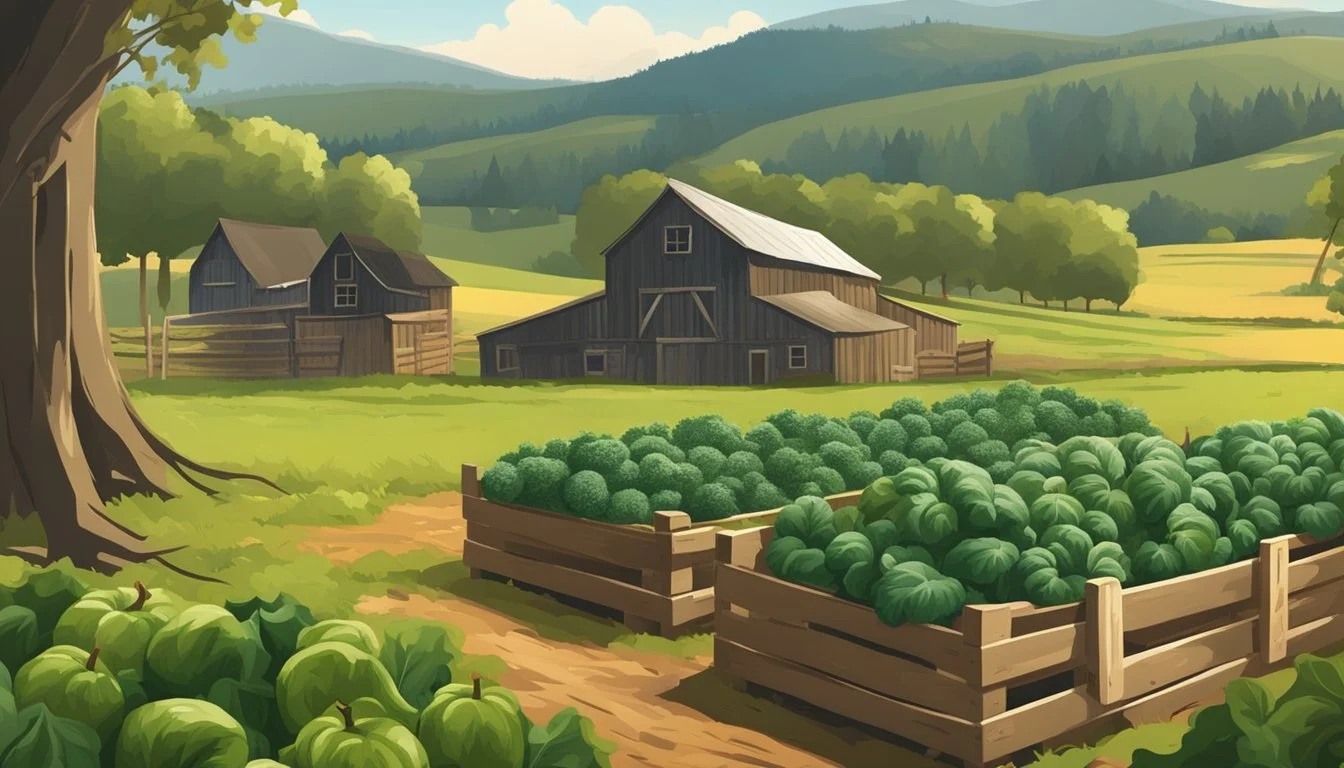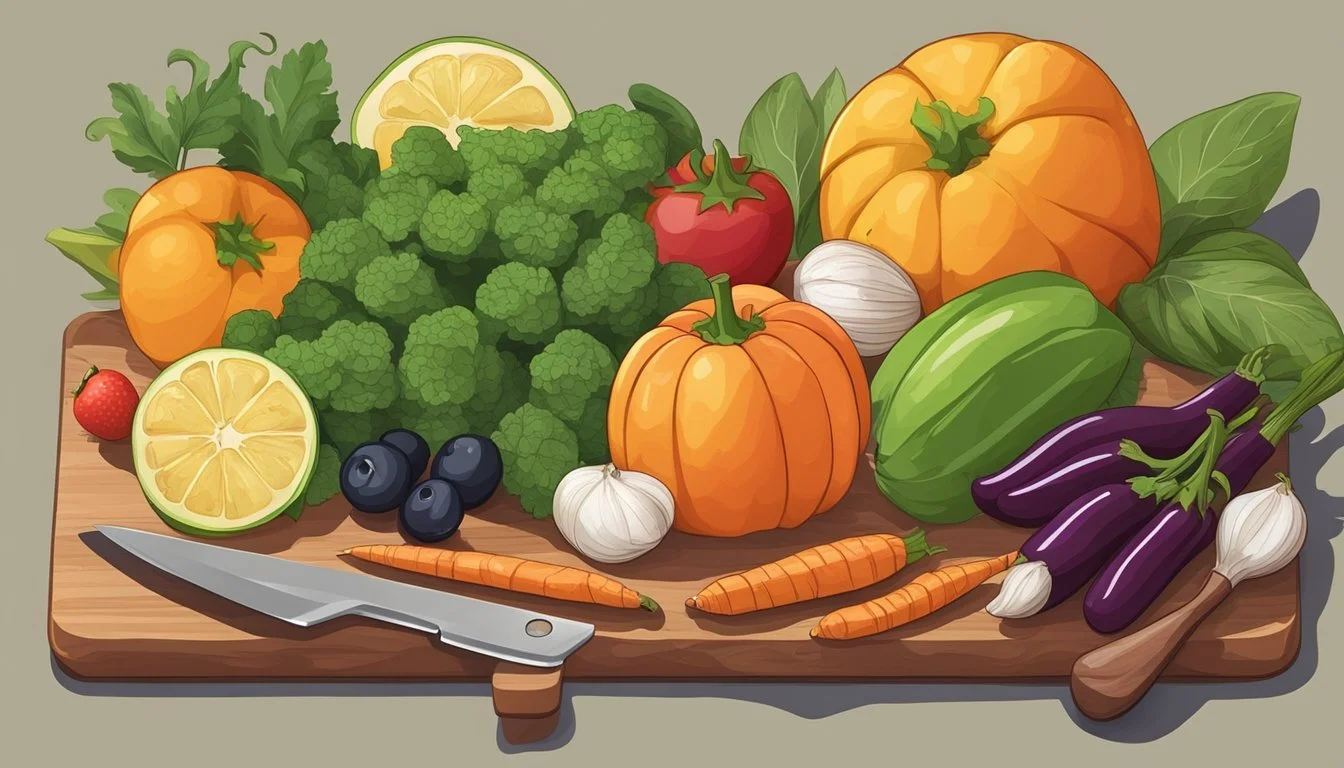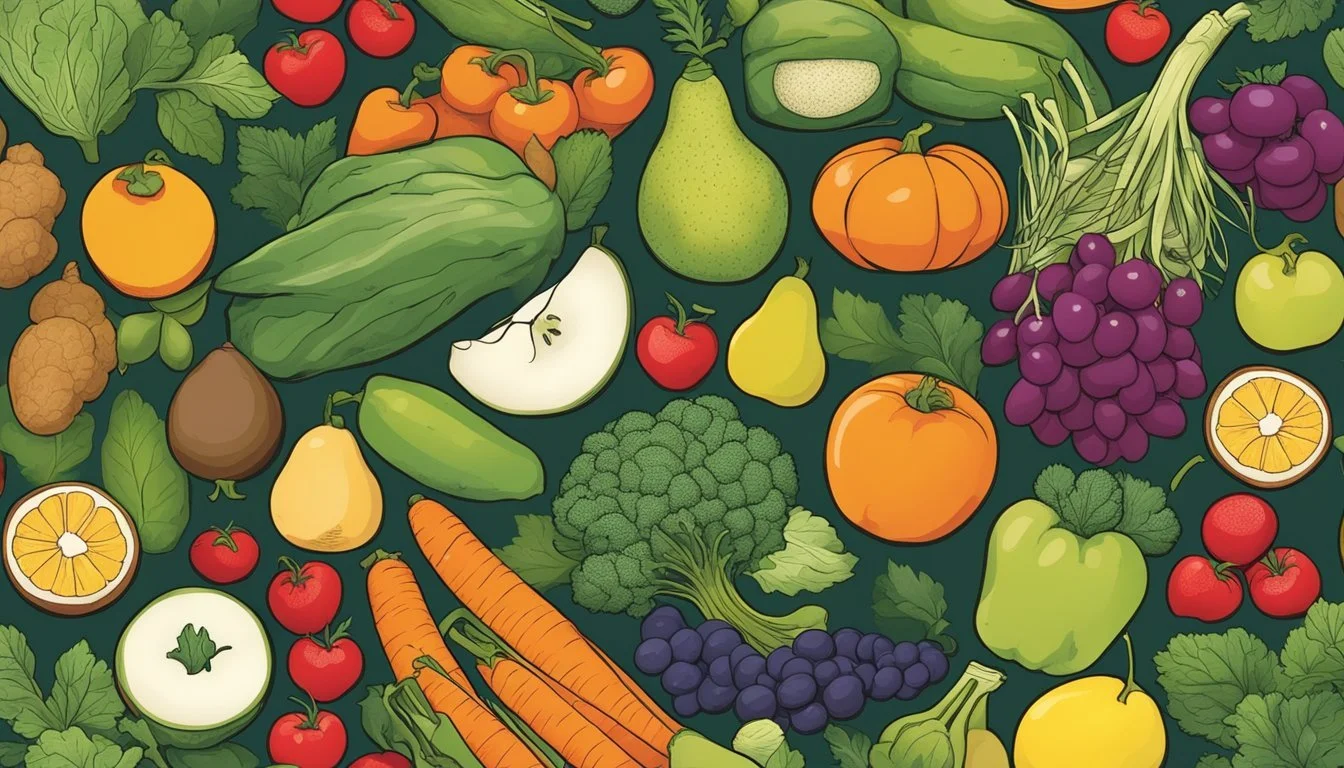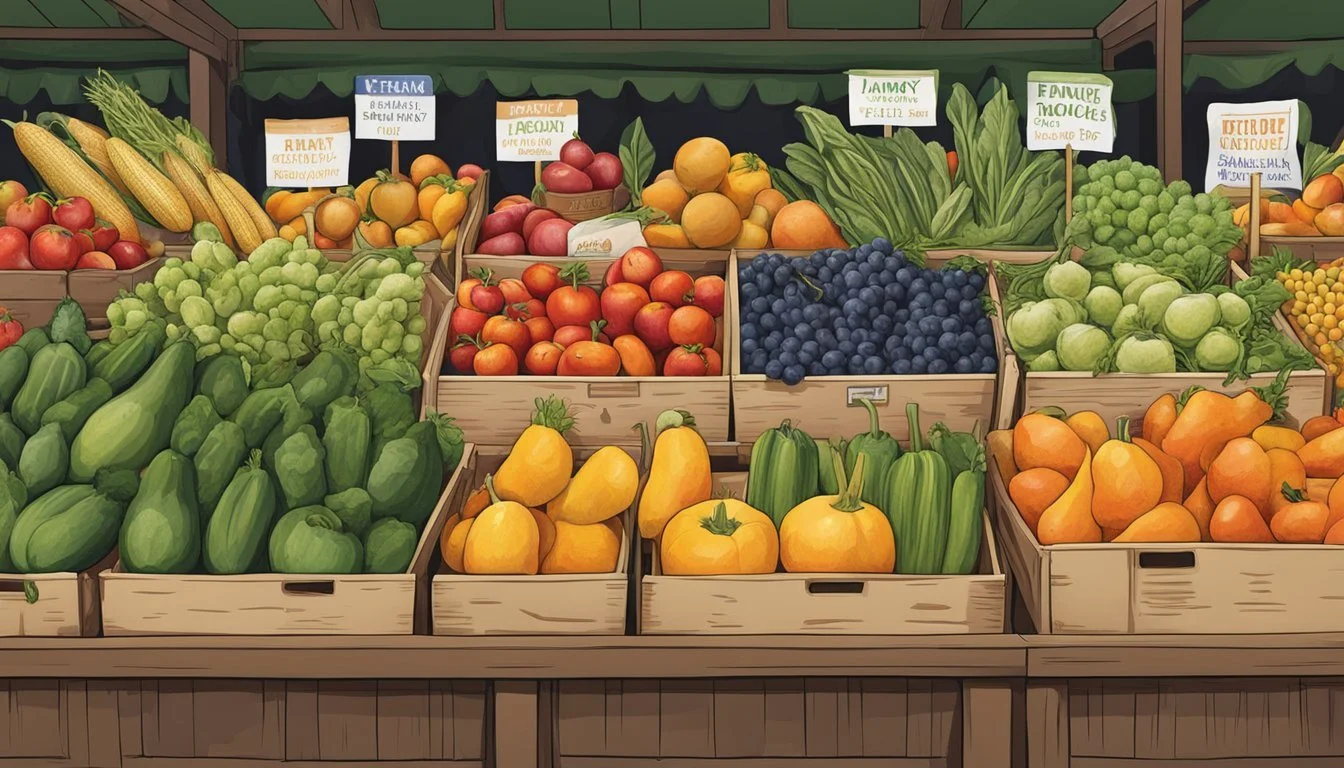Kentucky Seasonal Fruit & Vegetables in January
A Guide to Winter Produce
This Article is Part of our Kentucky Seasonal Fruit & Veg Calendar
As the winter chill blankets Kentucky, residents and chefs alike turn their attention toward the fresh produce that thrives during the cold season. The month of January, though often associated with snow and sparse gardens, offers a surprising variety of fruits and vegetables that reach their peak in the Bluegrass State. Consumers can expect to find an abundance of hearty vegetables and a selection of fruits that add brightness to winter dishes.
The seasonal palette during this period features robust vegetables like kale (What wine goes well with kale?) and broccoli. These greens are not only resilient in colder temperatures but also packed with nutrients, making them a staple for healthful cooking. Root vegetables also take center stage, with options such as sweet potatoes and turnips offering depth and comfort to any meal. While fruits may seem scarce, citrus varieties such as oranges and lemons are readily available, injecting a zesty flavor into wintery Kentucky days.
By focusing on these seasonal offerings, Kentuckians can enjoy fresh, nutritious food that supports local agriculture. The advantage of consuming in-season produce is twofold: it ensures the freshest taste and highest nutritional value, while also fostering community engagement with local farms and markets. January's produce selection embodies the resilience and richness of Kentucky's agricultural landscape, even in the midst of winter.
Understanding Kentucky's Seasonality
In Kentucky, seasonality greatly influences the availability of fresh produce throughout the year. The state's climate, marked by temperate weather patterns, allows for a diverse range of fruits and vegetables to flourish. January, part of the cold winter season, is not the peak time for most types of produce; however, the savvy consumer or chef can still find fresh, locally-grown items that thrive in cooler conditions.
Due to January's typically chilly temperatures, the fresh produce selection is more limited compared to the bountiful harvests of spring and summer. Despite this, there are hearty vegetables that withstand the winter weather, adding vital freshness to meals during this time.
Kentucky's fresh produce in January may include:
Root Vegetables: Such as carrots and turnips, which are often stored well into winter.
Leafy Greens: Including kale and collards, which can tolerate frost and even become sweeter with a touch of it.
Winter Squash: Varieties like butternut or acorn squash that are harvested in fall and store well into the winter.
Apples: Stored from the fall harvest, these remain a staple in the Kentucky winter diet.
Farmers utilize greenhouses and cold frames to extend the growing season of certain crops, thereby ensuring that even in the depths of January, residents and visitors can enjoy a selection of state-grown fresh produce. Understanding the state's seasonality helps one appreciate the natural rhythm of local agriculture and the importance of supporting local farmers year-round.
Seasonal Vegetables in January
In January, Kentucky's seasonal produce includes a variety of hardy root vegetables, nutritious leafy greens, and an array of cruciferous vegetables, each offering a wealth of flavor and health benefits during the winter season.
Root Vegetables
Turnips: These versatile roots provide a slightly peppery taste and can be enjoyed roasted, mashed, or in stews.
Carrots: Sweet and crunchy, carrots are ideal for snacking, soups, and side dishes.
Potatoes: A staple in many dishes, they offer comfort in the form of baked, mashed, or roasted preparations.
Sweet Potatoes: Loaded with vitamins, sweet potatoes can be baked, turned into fries, or used in pies for a nutritious twist.
Leafy Greens
Kale: Rich in nutrients, kale is perfect for salads, smoothies, or sautéed as a side.
Collards: With a hearty texture, collards stand up well to longer cooking times, ideal for traditional Southern dishes.
Cruciferous Vegetables
Cabbage: Its versatility allows it to be used in slaws, soups, and fermented dishes like sauerkraut (how long does sauerkraut last?).
Brussels Sprouts (how long do brussels sprouts last?): Roasted Brussels sprouts bring a nutty flavor to the winter table, often enhanced with just a touch of browning.
Seasonal Fruits in January
In Kentucky, January is a month where certain fruits, particularly citrus varieties, are at their peak of freshness and flavor, providing both a tasty and nutritious option during the winter season.
Citrus Fruits
Oranges: Oranges are a versatile and widely enjoyed citrus fruit. Rich in vitamin C and antioxidants, they are a healthy selection readily available in January. They are ideal for fresh consumption, juices, and in various culinary applications.
Grapefruit: Known for its slightly tart and tangy flavor, grapefruit comes into season. It's packed with vitamins A and C, making it an excellent choice for boosting immunity during the colder months.
Lemons: Lemons are another citrus staple with high vitamin C content. They are often used to add a fresh zest to dishes and are essential for many recipes, including those for drinks, desserts, and savory meals.
Pomegranates: While not a citrus fruit, pomegranates are also in season during January. They are known for their deep red seeds, called arils, which are full of fiber, vitamins, minerals, and bioactive plant compounds with powerful medicinal properties.
Harvest and Storage Tips
In January, Kentucky's harvest basket has fewer fresh offerings due to the cold climate. However, root vegetables and some fruits, especially those stored from previous months, remain available. Here are some tips for harvesting and storing the January picks:
When it comes to root vegetables, they are best harvested when they are firm and unblemished. Store them in a cool, dark place to maintain their freshness. For instance:
Apples: These should ideally be picked when ripe and stored in a refrigerator or a cool cellar to extend their shelf life.
Beets: Harvest these when they are medium-sized for the best flavor, and store them in a cool, humid place after removing the tops.
Leafy greens can often be harvested even in the chilly months if grown in protective structures like cold frames or greenhouses. They should be consumed quickly as they do not store well for extended periods.
Use the following table for reference on how to handle January produce:
Food Item Harvest Indicators Storage Method Apples Firm, no soft spots Refrigerator in a plastic bag Beets Medium-sized, firm Cool, humid place without tops Greens Vibrant color, no wilting Refrigerator, consumed promptly
Consumers should be mindful of food wastage by only purchasing what they can reasonably consume, ensuring fresh-tasting produce and peak nutrition. They can extend the season's bounty by utilizing proper storage methods, helping to enjoy the flavors of even the coldest month.
Cooking and Recipe Ideas
January in Kentucky brings a variety of hearty produce, suitable for warm, comforting dishes. Root vegetables and robust greens dominate this season, lending themselves to an array of flavorful recipes.
Soups and Stews: These are perfect for cold January days. Utilizing seasonal vegetables like turnips and kale, one can create a wholesome Beef and Vegetable Stew. Adding a sweet element like carrots and a tangy twist with a dash of vinegar can enrich the flavors.
Salads and Slaws: For a lighter fare, a Kale and Citrus Salad offers a refreshing mix. The sweetness of citrus fruits pairs well with the bitter notes of kale, while a honey-lemon dressing can provide a silky balance.
Sides: Cabbage, a January staple, can be transformed into a tangy slaw, perfect alongside a hearty main dish. Adding apples for a touch of sweetness can make it a crowd-pleaser.
Hearty Greens: Sautéed Kale with Garlic is both simple and nutritious, bringing out the earthy flavors of the greens.
Recipes Main Ingredients Beef and Vegetable Stew Turnips, Carrots, Kale Kale and Citrus Salad Kale, Oranges, Lemon Juice Sweet and Tangy Slaw Cabbage, Apples, Vinegar Sautéed Kale with Garlic Kale, Garlic
In conclusion, Kentucky's January produce should be celebrated with a variety of cooking methods that enhance their natural flavors, from sweet to sour, creating dishes that comfort and refresh during the winter season.
Health Benefits of Seasonal Eating
Eating seasonally is tied to numerous health advantages. When individuals choose fruits and vegetables that are in peak season, they often receive higher levels of nutrients because these items are picked at their prime. Nutritional benefits are more pronounced in produce harvested at the right time since vitamins like C and A, along with crucial phytonutrients, are at their highest natural levels.
Seasonal eating also promotes a diverse diet that varies throughout the year. This diversity ensures a broader spectrum of nutrients, thus supporting overall health. For instance, winter produce such as root vegetables are rich in complex carbohydrates, fiber, and vitamins, all necessary for maintaining energy levels in colder weather.
Incorporating seasonal foods can further the following health benefits:
Immunity boost: Seasonal fruits and vegetables contain nutrients vital for immune system function.
Digestive health: High-fiber seasonal items aid digestion and can help prevent certain diseases.
Chronic disease prevention: Fresh produce has antioxidants that can reduce the risk of chronic diseases.
An additional advantage to seasonal eating is its alignment with the body’s nutritional needs. For example, summer fruits provide hydration and vitamins necessary to deal with heat, while winter necessitates calorie-dense foods to generate heat.']>; Consuming seasonal foods not only nourishes the body effectively but also supports local farming communities, ensuring that what one eats has not traveled long distances, which could potentially diminish its nutritional value. It's a win-win: the individual benefits from the freshness of the product, and the local economy thrives.
Planning Your Seasonal Kitchen
When planning a kitchen that maximizes the use of seasonal produce, one must consider the variety and versatility of ingredients available. January in Kentucky presents a selection of fruits and vegetables that can enhance both the nutrition and flavor of meals.
In-season fruits that a cook might include are:
Citrus fruits (oranges, grapefruits, tangerines)
Apples (limited varieties)
These fruits are perfect for both eating fresh and incorporating into dishes, as they offer a burst of brightness during winter months.
Available vegetables include:
Kale
Broccoli
Cauliflower
Potatoes
Sweet potatoes
Vegetables like broccoli and cauliflower can be roasted, steamed, or included in stir-fries, making them highly versatile for meal preparation.
Meal prep strategies might feature:
Blanching and freezing greens for later use
Roasting a variety of root vegetables for easy side dishes
Preparing citrus segments or zest to add to salads, desserts, or marinades
Planning a kitchen around seasonal produce not only ensures the freshest taste but also supports local farmers. It requires an understanding of what is readily available and how it can be adapted across various styles of cooking. In January, meal prep becomes a pivot point for creativity, turning seasonal produce into nourishing, cozy dishes perfect for winter dining.
Supporting Local Kentucky Farmers
In January, Kentucky's local farmers provide a variety of seasonal produce despite the cold weather. One can support these dedicated farmers by engaging with community-driven food systems. Farmers markets operate even during winter months, offering locally grown goods that often surpass store-bought counterparts in freshness and quality.
Farmers Markets and Community Supported Agriculture (CSA)
CSA programs encourage direct support of local farmers.
Consumers subscribe for regular produce deliveries, ensuring a consistent market for farmers.
The variety of goods includes winter produce like squashes and root vegetables.
The Benefits of Buying Local Economic Impact: Purchasing from local farmers directly contributes to the Kentucky economy and ensures the viability of farming in the community. Freshness: Local produce is often harvested at peak ripeness, ensuring a fresh and flavor-rich addition to your table. Sustainability: Shorter transportation distances mean less environmental impact, promoting sustainability.
Where to Find Local Produce in January
Indoor farmers markets adapt to the colder months, permitting year-round access to local goods.
Specialty stores and co-ops often stock locally sourced produce.
Engaging with local Kentucky farms through these channels nurtures a strong community bond and fosters a resilient local food system. Consumers receive quality produce, and farmers get valuable support to continue their essential work.








